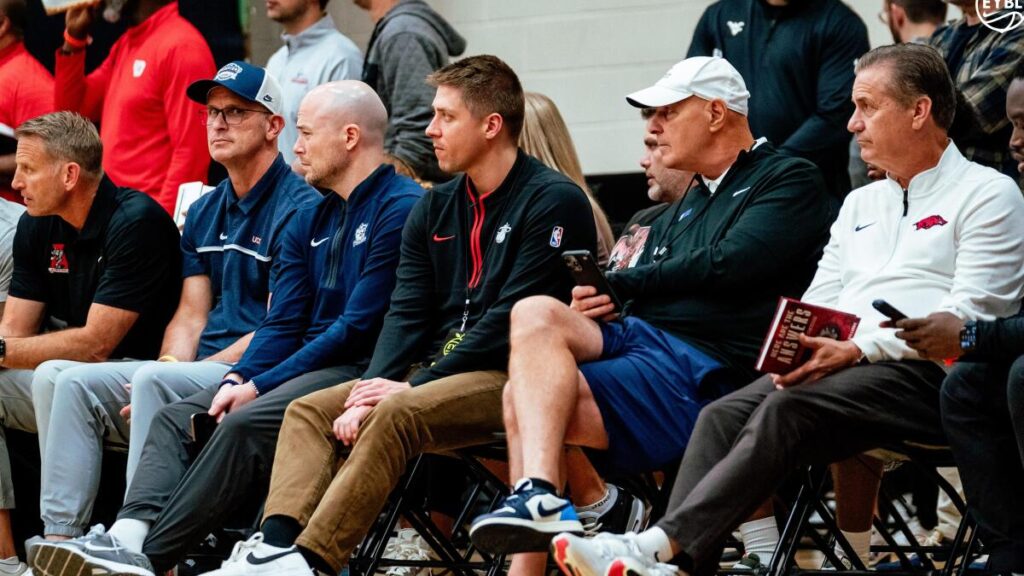The summer recruiting period has come to an end, and one of the biggest subjects of conversation around grassroots basketball over the last few months has been the collective strength, or lack thereof, in the rising senior class of 2026.
To be clear, the 2026 class is not viewed as a collectively strong class. In many ways, it is reminiscent of the national class of 2023, which was headlined by the likes of Ron Holland and Isaiah Collier. The lack of star power atop that class led to a relatively weak 2024 NBA Draft. After observing the 2026 recruiting class for the last few years, its clear that the lack of overwhelming talent could have similar implications on the 2027 draft.
Forward-thinking NBA front offices know the 2027 draft will be weak at the top and have been planning accordingly, even while recognizing that prospects can emerge at various stages, including long after high school. The valuation of draft assets in 2027 are notably lower than say the upcoming 2026 draft, which is viewed as a strong one, or even later ones in 2028 and beyond.
But what about the implications on college basketball?
The worlds of recruiting and roster construction are vastly different now than they were even just three years ago. It’s still true that the very top prospects often arrive on college campuses with one-and-done expectations. That will again be true with the 2026 group of freshmen. The complicating factor now is that the top-ranked prospects are also expecting premium NIL packages. The big question with this class is just how much money college programs can afford to allocate to these potential freshmen who don’t match the level of talent from the last two classes (2024 and 2025). Based on our scouting and evaluation of the 2026 class, the return on the top-ranked freshman just won’t be the same in terms of production and impact on winning.
From my standpoint, this class has some highly talented long-term prospects and some prospects who are very impactful players right now. They don’t have many who check both boxes consistently and reliably right now.
Prospects like Christian Collins, Tahj Ariza, Cameron Williams, and even Tyran Stokes – have tools to intrigue NBA decision makers even if they’re not prepared to drive winning right away as college freshmen. Collins is the glaring example. He’s the No. 4 player in the 2026 class, but there was a game at the Peach Jam where he only scored two points. His ranking is less a reflection of where his game is right now, and more where we believe it can be in the future.
Others like Jason Crowe Jr., Jordan Smith, and Caleb Holt probably can impact winning right away, but still have major questions about how they could ultimately translate to the highest levels in a couple of years. Crowe is a prolific scorer but lacks ideal size, length, and athleticism. Smith and Holt have all those physical tools, along with ideal intangibles, but need to expand their skill sets.
No. 1-ranked Stokes is the only prospect in the 2026 class whose talent matches the top end of the last two classes and who can produce at a similar elite level when he gets going. But Stokes is still inconsistent and isn’t nearly as reliable when it comes to driving winning. Paired with another five-star in Crowe Jr., Stokes and the Oakland Soldiers went 3-2 at the Peach Jam and didn’t even make it out of pool play.
So as the college bluebloods recruit the 2026 class and make financial decisions that impact the entire roster, they have some tough calls to make. College staffs have to weigh the risk and the reward of taking the type of talent who could very possibly underperform relative to their ranking and still get drafted, versus the type who could make an instant impact in college but not have the draft outcome that their ranking normally correlates to.
Ultimately, I’m just not sure you can make a Final Four relying primarily on so-called one-and-done talent in this class. Those players will be costly, eat up too much of the budget, and may not be able to generate the desired immediate return on that investment at the college level. That begs the question – could taking a player ranked outside the top 10 or top 15 who stays two or three years in college be more cost-efficient, productive, and drive winning for more years, be more valuable than spending the money for a one-and-done freshman in the top 10 of the 2026 class?
My expectation is that it just might. So, as counter-intuitive as it may sound, I will not be surprised to see players ranked in the 20s and 30s get more recruitment than players in the top ten. They’ll come at a cheaper price point, still be able to at least contribute right away, and yet be more open-minded to staying for multiple years and growing into bigger roles in time.
By extension, I think we’ll see programs double down on international markets, the transfer portal, and player retention next spring. Remember, the 2026 NBA Draft looks like a very strong one, so getting players to return for another year could be mutually beneficial for both the individual and collective program.
The college recruitment of high school players has changed drastically over the last few seasons, none more so than what we are seeing for the 2026 cycle. Revenue share, NIL, and the transfer portal play an increasingly large role in how teams construct rosters, creating a direct impact on high school recruiting as well. The lack of high-end talent within the top 10, the strategy and approach that colleges use for this cycle, will be more interesting to track.
Read the full article here



